In the 1910s, Else Frölich (1880-1960) was one of the leading actresses of the Danish Nordisk Company. In many Nordisk films, she was paired with the male star of those years, Valdemar Psilander, as in the beautifully restored Evangelimandens liv/The Candle and the Moth (Holger-Madsen, 1915). She also often played in vehicles which were designed specially for her.
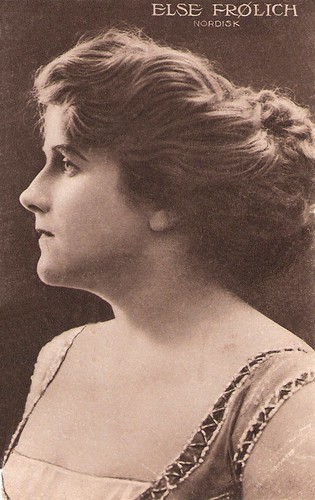
Danish postcard. Photo: Nordisk.

Austrian postcard by Postkartenverlag Brüder Kohn, Vienna, 1916. Valdemar Psilander and Else Fröhlich in Gaestesspillet/One Life, One Love (Eduard Schnedler-Sörensen, 1913).
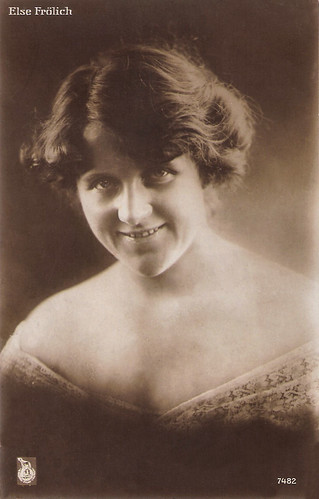
German postcard, no. 7482. Photo: Nordisk.
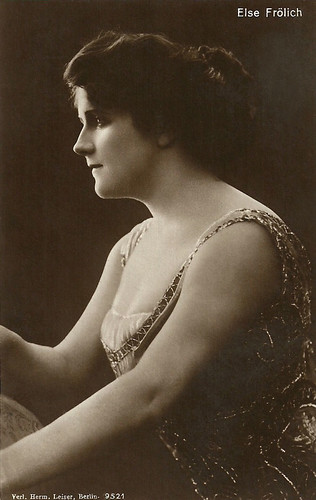
German postcard by Verlag Hermann Leiser, Berlin, no. 9521.
Else Frölich (also written as Else Frølich or Else Fröhlich) was born Eli Marie Thaulow in Paris in 1880. She was the daughter of the Norwegian painter Fritz Thaulow and a Danish mother, Ingeborg Gad, a cousin of the film director Urban Gad. Fritz Thaulow lived in Paris as an international celebrity, and Ingeborg's sister Mette was married to the French painter Paul Gauguin. At the age of 3 years, Eli came to Denmark, when her mother married for a second time with Edvard Brandes, whom Eli considered her father.
In 1903 Eli married the Danish singer Louis Frölich, whom she divorced in later years (unknown when), but whose name she kept. As a 17-year-old she studied singing in Paris and performed with her husband both in Paris and in the Scandinavian countries. She had her first big success with Bear Bjørnsson at the Nationalteatret (National Theatre) in Oslo, where she played the title role in 'Den glade Enke' (The Merry Widow) in 1907. At the Ny Teater (New Theatre) in Copenhagen, she had a huge success with the 'Dollarprinsessen' (Dollar Princess) in 1909.
In 1911 she started to perform in short silent films at the Nordisk film studio and throughout her film career she was exclusively employed there. One of her first appearances was in En lektion/A Lesson (August Blom, 1911) opposite Valdemar Psilander. 9 more films followed in 1912. First, she played in Guvernorens datter/The Governor's Daughter (August Blom, 1912) with Robert Dinesen, and En staerkere magt/A Powerful Force (Hjalmar Davidsen, Eduard Schnedler-Sorensen, 1912).
Then followed five films with Valdemar Psilander and Fröhlich in the leads: Tropisk kaerlighed/Tropical Love (August Blom, 1912), Livets baal/Life's Bonfire (Eduard Schnedler-Sorensen, 1912), Jerbanens dotter/Rail Daughter (August Blom, 1912), Den staerkeste/Vanquished (Eduard Schnedler-Sorensen, Bernhard Holz, 1912), and For Abent Taeppe/Desdemona (August Blom, 1912) in which Psilander and Fröhlich are a couple playing Othello and Desdemona and recognising their own situation. Next came - still in 1912, Hjaerternes kamp/A High Stake (August Blom, 1912) with Dinesen, and Badets dronning/The Queen of the Season (Eduard Schnedler-Sorensen, 1912).
In 1913 Else played in the comedies Skandalen paa Sorupgaard/The Scandal of Sorupgaard (Hjalmar Davidsen, 1913) with Psilander, Kaerlighed og penge/Outwitted (Leo Tscherning, 1913), and Djaevelens datter/Devil's daughter (Robert Dinesen, 1913). Director Dinesen also co-starred in this film. The following year she starred a.o. in Detektivens barnepige/Detective Nurse (Hjalmar Davidsen, 1914) and Det gamle fyrtaarn/The Old Lighthouse (A.W. Sandberg, 1914).
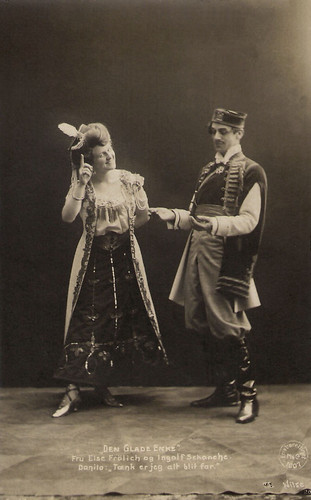
Danish postcard by Ensberelinget M & Co, no. 20, 1907. Photo: Nilse. Publicity still for the Franz Lehar operetta 'Den Glade Enke' (The Merry Widow). 'The Merry Widow' premiered in 1905, and the operetta came to Denmark in 1906, where it again was a great success. A year later it was presented in Norway at the Nationalteatret (National Theatre). Else Frölich made her stage début in the title role. Ingolf Schanche played Count Danilo. On the postcard, he says: "Thinking I'm all grown father".
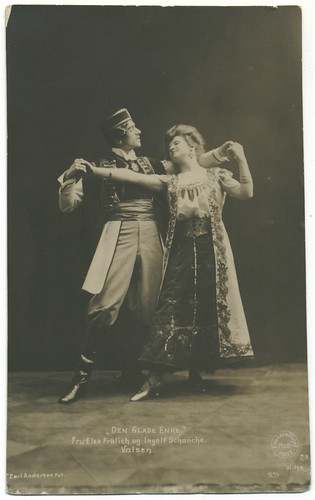
Danish postcard by Valsen_Ensberettiget, no. 29. Photo: Carl Andersen. Collection: Manuel Palomino Arjona (Flickr). Else Frölich and Ingolf Schanche in 'Den Glade Enke' (The Merry Widow).
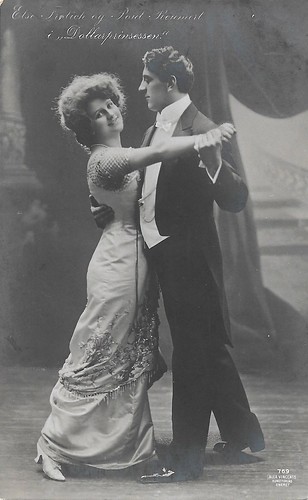
Danish postcard by Alex Vincent's Konstforlag, Eneret, no. 769. Poul Reumert and Else Frölich in the Operetta 'Dollarprinzessin' (Dollar Princess) by Leo Fall, performed in 1909 when both worked at the Copenhagen Ny Teater (New Theatre).
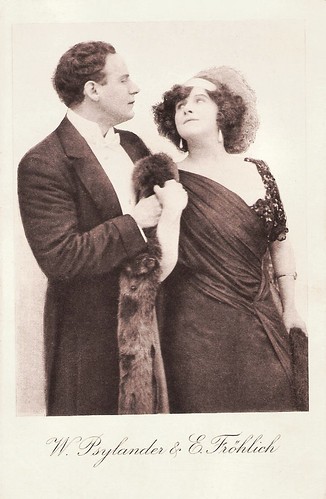
Austrian postcard by Edition Projectograph A.G., no. B.K.W.I. Kino 25. Photo: Else Frölich and Valdemar Psilander in Gæstespillet/Guest Game (Eduard Schnedler-Sørensen, 1913) with Valdemar Psilander.
Else Fröhlich was the leading female star of Nordisk along with Clara Wieth and Ebba Thomsen, and she continued to play leading roles in numerous films. In 1915 she starred in Evangeliemandens liv/The Candle and the Moth (Holger-Madsen, 1915), a star vehicle for Valdemar Psilander as the spoiled brat who redeems himself in prison, finds faith and becomes a clergyman.
With her a bit chubby but towering beauty she was perfect for the major (erotic) love dramas, where she often played opposite Psilander or Anton de Verdier. She appeared in En opstandelse/A Resurrection (Holger-Madsen, 1915) with Psilander, Millionaeren i roverhaender/Millionaire in Robber's Hands (A.W. Sandberg, 1915), Kampen om barnet/Battle for the Children (Hjalmar Davidsen, 1915), and Cowboymillionaeren/Cowboy Millionaire (Lau Lauritzen Sr., 1915), with Olaf Fönss.
Else Frölich appeared again with Valdemar Psilander in I livets braending/Crossroads of Life (Holger-Madsen, 1916) but it was probably their last film together before he died. On 6 March 1917, Psilander committed suicide. It meant the end of the many films of Frölich with the Danish star. In 1916 Frölich also appeared in Hendes fortid/Her Past (A.W. Sandberg, 1916), Katastrofen i Kattegat/The Disaster in the Kattengat (A.W. Sandberg, 1916), Gentlemansekretaeren/Gentleman Secretary (1916) with Olaf Fönss, and For syn faders skyld/For His Father's Sake (Holger-Madsen, 1916). In 1916 Else Frölich married film director A.W. Sandberg. They stayed together until he died in 1938.
In 1917-1918, Fröhlich only made a handful of films. She appeared in Den raetferdiges hustru/The Righteous Wife (A.W. Sandberg, 1917) with Gunnar Tolnaes, Et bjarneherte/A Child's Heart (Hjalmar Davidsen, 1917). Finally, she played in De mystiske fodspor/The Mysterious Footprints (A.W. Sandberg, 1918) with Carl Brisson, and Solen der draebte/The Sun that Killed (Hjalmar Davidsen, 1918). Her co-star in the latter was the upcoming new film star Nils Asther, who later would pursue a career in Hollywood.
After a short but intense career, Fröhlich retired from the film set in 1918. She participated in the preparation of manuscripts, including Klovnen/Clown (based on an idea by Carl Alstrup) and some Charles Dickens adaptations of her husband. Till 1934, she managed the cinema Merry-Biografen with her son, Henrik Sandberg. Henrik later became a prolific and successful film producer. Else Frölich died in 1960. The Danish Film Institute has released a DVD with films with Psilander and Frölich such as Evangeliemandens liv/The Candle and the Moth (Holger-Madsen, 1915), while Eye Nederlands Filmmuseum owns copies of films like Guvernorens datter/The Governor's Daughter (August Blom, 1912).

Austrian postcard by B.K.W.I. (Brüder Kohn, Wien), no. 3. Photo: Projektograph Aktiengesellschaft, Vienna, distributor of Nordisk Films Co, Copenhagen. Valdemar Psilander and Else Fröhlich in Gæstespillet/One Life One Love (Eduard Schnedler-Sørensen, 1913).
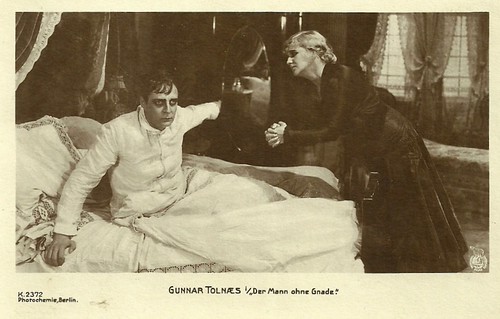
German postcard by Photochemie, no. K.2372. Photo: Nordisk Films. Gunnar Tolnaes and Else Frölich in Den Retfærdiges Hustru/The Wife of the Righteous (A.W. Sandberg, 1917). The German title was Der Mann ohne Gnade.
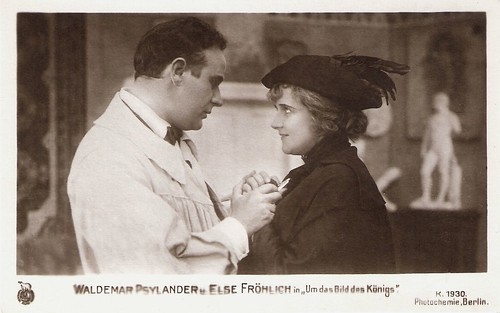
German postcard by Photochemie, Berlin, no. K.1943. Photo: Nordisk Films. Else Frölich and Valdemar Psilander in Rytterstatuen/The Knight's Statue (A.W. Sandberg 1919). Its German release title was Um das Bild des Königs (For the King's statue).
Sources: Det Danske Filminstitut (Danish), Wikipedia (Danish) and IMDb.
This post was last updated on 20 April 2024.

Danish postcard. Photo: Nordisk.

Austrian postcard by Postkartenverlag Brüder Kohn, Vienna, 1916. Valdemar Psilander and Else Fröhlich in Gaestesspillet/One Life, One Love (Eduard Schnedler-Sörensen, 1913).

German postcard, no. 7482. Photo: Nordisk.

German postcard by Verlag Hermann Leiser, Berlin, no. 9521.
The Queen of the Season
Else Frölich (also written as Else Frølich or Else Fröhlich) was born Eli Marie Thaulow in Paris in 1880. She was the daughter of the Norwegian painter Fritz Thaulow and a Danish mother, Ingeborg Gad, a cousin of the film director Urban Gad. Fritz Thaulow lived in Paris as an international celebrity, and Ingeborg's sister Mette was married to the French painter Paul Gauguin. At the age of 3 years, Eli came to Denmark, when her mother married for a second time with Edvard Brandes, whom Eli considered her father.
In 1903 Eli married the Danish singer Louis Frölich, whom she divorced in later years (unknown when), but whose name she kept. As a 17-year-old she studied singing in Paris and performed with her husband both in Paris and in the Scandinavian countries. She had her first big success with Bear Bjørnsson at the Nationalteatret (National Theatre) in Oslo, where she played the title role in 'Den glade Enke' (The Merry Widow) in 1907. At the Ny Teater (New Theatre) in Copenhagen, she had a huge success with the 'Dollarprinsessen' (Dollar Princess) in 1909.
In 1911 she started to perform in short silent films at the Nordisk film studio and throughout her film career she was exclusively employed there. One of her first appearances was in En lektion/A Lesson (August Blom, 1911) opposite Valdemar Psilander. 9 more films followed in 1912. First, she played in Guvernorens datter/The Governor's Daughter (August Blom, 1912) with Robert Dinesen, and En staerkere magt/A Powerful Force (Hjalmar Davidsen, Eduard Schnedler-Sorensen, 1912).
Then followed five films with Valdemar Psilander and Fröhlich in the leads: Tropisk kaerlighed/Tropical Love (August Blom, 1912), Livets baal/Life's Bonfire (Eduard Schnedler-Sorensen, 1912), Jerbanens dotter/Rail Daughter (August Blom, 1912), Den staerkeste/Vanquished (Eduard Schnedler-Sorensen, Bernhard Holz, 1912), and For Abent Taeppe/Desdemona (August Blom, 1912) in which Psilander and Fröhlich are a couple playing Othello and Desdemona and recognising their own situation. Next came - still in 1912, Hjaerternes kamp/A High Stake (August Blom, 1912) with Dinesen, and Badets dronning/The Queen of the Season (Eduard Schnedler-Sorensen, 1912).
In 1913 Else played in the comedies Skandalen paa Sorupgaard/The Scandal of Sorupgaard (Hjalmar Davidsen, 1913) with Psilander, Kaerlighed og penge/Outwitted (Leo Tscherning, 1913), and Djaevelens datter/Devil's daughter (Robert Dinesen, 1913). Director Dinesen also co-starred in this film. The following year she starred a.o. in Detektivens barnepige/Detective Nurse (Hjalmar Davidsen, 1914) and Det gamle fyrtaarn/The Old Lighthouse (A.W. Sandberg, 1914).

Danish postcard by Ensberelinget M & Co, no. 20, 1907. Photo: Nilse. Publicity still for the Franz Lehar operetta 'Den Glade Enke' (The Merry Widow). 'The Merry Widow' premiered in 1905, and the operetta came to Denmark in 1906, where it again was a great success. A year later it was presented in Norway at the Nationalteatret (National Theatre). Else Frölich made her stage début in the title role. Ingolf Schanche played Count Danilo. On the postcard, he says: "Thinking I'm all grown father".

Danish postcard by Valsen_Ensberettiget, no. 29. Photo: Carl Andersen. Collection: Manuel Palomino Arjona (Flickr). Else Frölich and Ingolf Schanche in 'Den Glade Enke' (The Merry Widow).

Danish postcard by Alex Vincent's Konstforlag, Eneret, no. 769. Poul Reumert and Else Frölich in the Operetta 'Dollarprinzessin' (Dollar Princess) by Leo Fall, performed in 1909 when both worked at the Copenhagen Ny Teater (New Theatre).

Austrian postcard by Edition Projectograph A.G., no. B.K.W.I. Kino 25. Photo: Else Frölich and Valdemar Psilander in Gæstespillet/Guest Game (Eduard Schnedler-Sørensen, 1913) with Valdemar Psilander.
The candle and the moth
Else Fröhlich was the leading female star of Nordisk along with Clara Wieth and Ebba Thomsen, and she continued to play leading roles in numerous films. In 1915 she starred in Evangeliemandens liv/The Candle and the Moth (Holger-Madsen, 1915), a star vehicle for Valdemar Psilander as the spoiled brat who redeems himself in prison, finds faith and becomes a clergyman.
With her a bit chubby but towering beauty she was perfect for the major (erotic) love dramas, where she often played opposite Psilander or Anton de Verdier. She appeared in En opstandelse/A Resurrection (Holger-Madsen, 1915) with Psilander, Millionaeren i roverhaender/Millionaire in Robber's Hands (A.W. Sandberg, 1915), Kampen om barnet/Battle for the Children (Hjalmar Davidsen, 1915), and Cowboymillionaeren/Cowboy Millionaire (Lau Lauritzen Sr., 1915), with Olaf Fönss.
Else Frölich appeared again with Valdemar Psilander in I livets braending/Crossroads of Life (Holger-Madsen, 1916) but it was probably their last film together before he died. On 6 March 1917, Psilander committed suicide. It meant the end of the many films of Frölich with the Danish star. In 1916 Frölich also appeared in Hendes fortid/Her Past (A.W. Sandberg, 1916), Katastrofen i Kattegat/The Disaster in the Kattengat (A.W. Sandberg, 1916), Gentlemansekretaeren/Gentleman Secretary (1916) with Olaf Fönss, and For syn faders skyld/For His Father's Sake (Holger-Madsen, 1916). In 1916 Else Frölich married film director A.W. Sandberg. They stayed together until he died in 1938.
In 1917-1918, Fröhlich only made a handful of films. She appeared in Den raetferdiges hustru/The Righteous Wife (A.W. Sandberg, 1917) with Gunnar Tolnaes, Et bjarneherte/A Child's Heart (Hjalmar Davidsen, 1917). Finally, she played in De mystiske fodspor/The Mysterious Footprints (A.W. Sandberg, 1918) with Carl Brisson, and Solen der draebte/The Sun that Killed (Hjalmar Davidsen, 1918). Her co-star in the latter was the upcoming new film star Nils Asther, who later would pursue a career in Hollywood.
After a short but intense career, Fröhlich retired from the film set in 1918. She participated in the preparation of manuscripts, including Klovnen/Clown (based on an idea by Carl Alstrup) and some Charles Dickens adaptations of her husband. Till 1934, she managed the cinema Merry-Biografen with her son, Henrik Sandberg. Henrik later became a prolific and successful film producer. Else Frölich died in 1960. The Danish Film Institute has released a DVD with films with Psilander and Frölich such as Evangeliemandens liv/The Candle and the Moth (Holger-Madsen, 1915), while Eye Nederlands Filmmuseum owns copies of films like Guvernorens datter/The Governor's Daughter (August Blom, 1912).

Austrian postcard by B.K.W.I. (Brüder Kohn, Wien), no. 3. Photo: Projektograph Aktiengesellschaft, Vienna, distributor of Nordisk Films Co, Copenhagen. Valdemar Psilander and Else Fröhlich in Gæstespillet/One Life One Love (Eduard Schnedler-Sørensen, 1913).

German postcard by Photochemie, no. K.2372. Photo: Nordisk Films. Gunnar Tolnaes and Else Frölich in Den Retfærdiges Hustru/The Wife of the Righteous (A.W. Sandberg, 1917). The German title was Der Mann ohne Gnade.

German postcard by Photochemie, Berlin, no. K.1943. Photo: Nordisk Films. Else Frölich and Valdemar Psilander in Rytterstatuen/The Knight's Statue (A.W. Sandberg 1919). Its German release title was Um das Bild des Königs (For the King's statue).
Sources: Det Danske Filminstitut (Danish), Wikipedia (Danish) and IMDb.
This post was last updated on 20 April 2024.
No comments:
Post a Comment